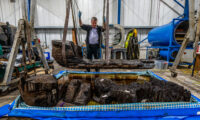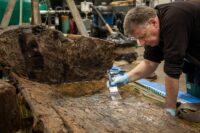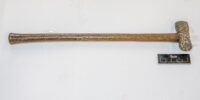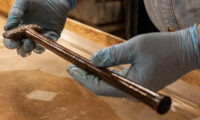 A 4,000-year-old Bronze Age wood coffin has been discovered in a golf course pond in Yorkshire. It contains human remains and an axe with a stone head and complete wooden handle in a condition so impeccable it could easily be confused for a tool of modern manufacture.
A 4,000-year-old Bronze Age wood coffin has been discovered in a golf course pond in Yorkshire. It contains human remains and an axe with a stone head and complete wooden handle in a condition so impeccable it could easily be confused for a tool of modern manufacture.
Workers were digging up a pond at Tetney Golf Club in July of 2018 with a mechanical excavator when they hit against the prehistoric coffin. They stopped what they were doing and called in an archaeologists from the University of Sheffield who arrived the next day to behold a muddy pit 12 feet deep with a wood coffin broken into several large pieces on the bottom. The wood, preserved for thousands of years in the waterlogged soil, was in immediate danger of drying out and falling apart from exposure to the air and the oppressive heat of the summer.
 The rescue archaeology operation revealed that the wood pieces were part of a log coffin, the carved trunk of a fast-growing oak tree. It was made with the “split timber” technique, in which the trunk is cut vertically into two halves, or two near-halves, with one side larger than the other. The larger half would then be hollowed out. The smaller half could be made into a lid. Only a part of the lid of this coffin has survived.
The rescue archaeology operation revealed that the wood pieces were part of a log coffin, the carved trunk of a fast-growing oak tree. It was made with the “split timber” technique, in which the trunk is cut vertically into two halves, or two near-halves, with one side larger than the other. The larger half would then be hollowed out. The smaller half could be made into a lid. Only a part of the lid of this coffin has survived.
Plants were used to cushion the body, then a gravel mound was raised over the grave; practices that were only afforded to people with a high status within Bronze Age society.
So far, yew or juniper leaves have been found within the coffin and further work is planned to discover more about how plants were used in this burial practice, and the time of year the burial took place.
Bronze Age log coffins are extremely rare; about 65 of them have been discovered in Britain. It was a brief-lived funerary practice that fell out of favor almost as quickly as it appeared about 4,000 years ago, and even if it had been more common, the decomposition of organic remains would destroy most of them.
Osteological analysis of the human remains found that he was a tall man for his time, about 5’9″, and died in his late 30s or early 40s. Osteoarthritis in his bones indicates he did heavy work. He was a man of importance in his community. Carving out a person-sized log was time-consuming and  resource-intensive; only the elite could afford so lavish a burial. The axe buried with him is also evidence he was a person of social rank. It is not a practical tool, but rather a ceremonial object, likely a symbol of authority. It is even more rare than the coffin. Only 12 from this period have been found in Britain.
resource-intensive; only the elite could afford so lavish a burial. The axe buried with him is also evidence he was a person of social rank. It is not a practical tool, but rather a ceremonial object, likely a symbol of authority. It is even more rare than the coffin. Only 12 from this period have been found in Britain.
The pieces of the coffin and the axe were transported to cold storage at the Mary Rose Trust in Portsmouth to arrest the decay and give researchers the  opportunity to study them before the drying and stabilization process caused any changes. They were in cold storage for a year before being moved to the York Archaeological Trust for preservation.
opportunity to study them before the drying and stabilization process caused any changes. They were in cold storage for a year before being moved to the York Archaeological Trust for preservation.
The largest piece is from one end of the coffin. It is almost eight feet long and weighs half a ton. The entire coffin is estimated to have been just under 10 feet long and just over three feet wide. Preserving the large, heavy coffin wood is going to take at least two years. The axe is expected to take about a year to preserve. When they are fully conserved, the coffin and axe will go on display at The Collection Museum in Lincoln near where they were discovered.
See conservator Ian Panter working on the coffin and axe in this video: